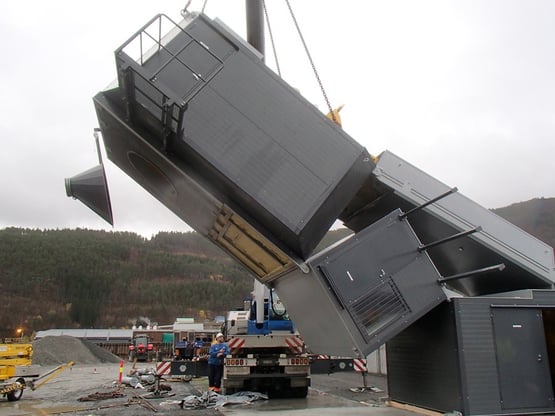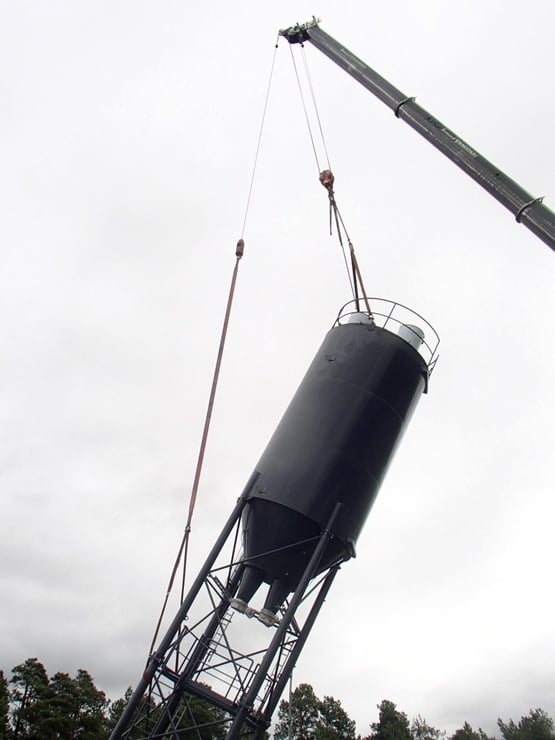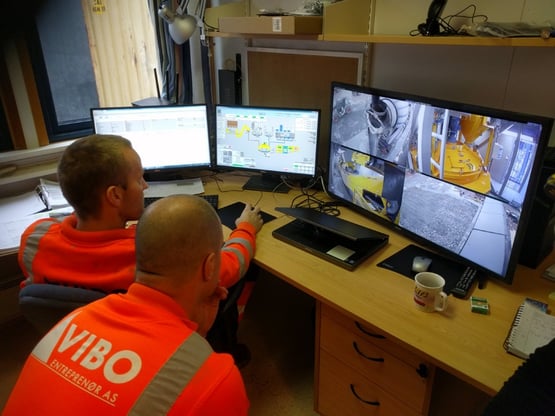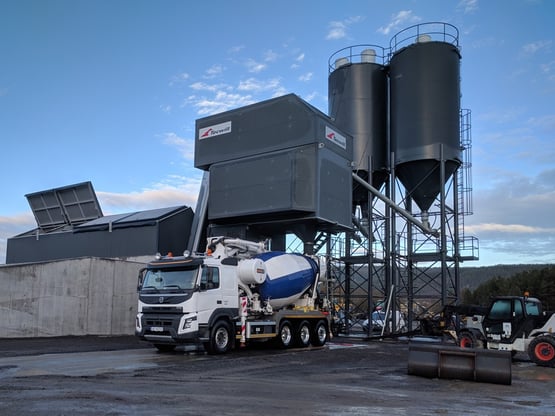Installation of a modern, winter equipped concrete mixing plant does not require any special tools. The most important device on the construction site is a mobile crane, to lift the modules and equipment from a truck onto the mobile foundations. Additionally a cherry picker is required in order to attach and detach the crane hooks at an altitude of several meters.
Furthermore only basic tools, such as socket wrench sets, drilling machines, screwdrivers and welding machines are required. On the personnel side a plumber, an electrician and 2-3 workers for basic installations are needed.
The mobile concrete mixing plant either requires a flat concrete foundation or a mobile substructure made of steel as well as ready-made water and electricity connections and a loading ramp to the aggregate bins.
How is the installation work of mobile concrete batching plant proceeding on a daily basis?
Lifting work with a mobile crane – one - two days
Day 1
The first step is to mark the correct positions for the plant modules. The next step is to lift the first module off the truck and put it onto the foundations. Generally, the first module to be lifted is the lower part of the aggregate bin. The second module is the mixing unit module, which, being one of a wet mix concrete plant, includes, a mixer. Preparatory work then needs to be carried out before the next lift. In the meantime e. g. the heating container for aggregate and water can be put onto the foundation.
All trucks will be unloaded on the day of arrival in order to avoid extra traffic on the site and waiting time for the trucks.

Day 2
At the beginning of the second day, the main module is already unfolded and placed in its operational position. The next step is to install the walkways for the personnel being able to move safely between separate floors without a hoist. While the mobile crane is still in the same position, the upper part of the aggregate bin is put on top of the lower part. When planning the installation schedule, the size and shape of the plot need to be taken into account. Careful planning can minimize the number of crane movements from one place to another and, if necessary, the arriving and lifting order of different modules can be changed.
The next step is to install the cement silos and screws. After that, the roof of the main module is lifted into its place and with this all the lifting work is completed. The crane is no longer needed and can leave for the next job.
After the main module is installed, the main power supply will be switched on and, if necessary, the facility heating. The water connection then can also be connected to the mobile concrete mixing plant.

Testing and training - further one- two days
Days 3 and 4
Once the lifting operations have been completed, the transport supports can be removed around devices. At this stage, the scales are hanging from the weighing sensors and the conveyor belts can be adjusted if necessary. Now the installation of the different devices gets finished so that their functions such as direction of rotation of motors, function of butterfly valves, pneumatic system and function of conveyors can be tested. For these tests, the control system computers need to be installed either in the mixing plant´s own control room or in the external control room.
Although a pre-testing of the concrete mixing plant has already been done before leaving the Tecwill factory, tests need to be carried out again in order to smoothly get the concrete production started.

Finishing work and the first concrete batch – two more days
Days 5 and 6
The first concrete test samples are going to be produced in this phase of the installation, which is why first of all the connection rubbers and the dust protection covers of the scales and conveyors need to be fixed properly. At the same time, it is necessary to verify the operation of the hydraulic system of the aggregate bin and the equipment for the binder silos in order to start with loading aggregates into the bins and filling the binding agent silos. Also the heating container gets connected to the mixing plant and its operation is tested.
As soon as the bins and silos are filled, the scale calibration can be started. The calibration requires calibration weights (either from Customer or automatic taring system included in delivery), which can be used to test the functioning of the scales from the 0 level up to the maximum level. After the calibration of the scales, the first "concrete batch", meaning that all the materials, which have been used during the calibration process, are emptied into the mixer; this batch then needs to be discharged and disposed.
Now that the mixing plant has been fully tested, the concrete production can start.
During these days, while doing the installation work, operators and service men have already received a good training. They have become familiar with the equipment and structures of the mixing plant as well as with the necessary maintenance work and adjustment targets.
The training of operators will be continued on the control system in use. The trainer guides and answers the questions so that the operators are “learning by doing”.
Concrete production with the new concrete mixing plant – the last two days
Days 7 and 8
During the next few days the concrete production continues. Now, the Tecwill technicians make sure that all the equipment is operating with the materials as planned.
The last training sessions involve both mechanics and electrification/automation. This ensures that the client is able to start the concrete production with peace of mind.
After completion of the commissioning, whenever needed, technical assistance is always available, e. g. by remote access or by technicians sent to the site. The remote access is the easiest way, allowing to monitor the functioning of the equipment and process directly from the office. This will make it easier for the customer to have a problem located and solved, not having to rely solely on a phone call or email.

Why choose Tecwill as a supplier?
Fast and easy installation does not require workers and equipment to stay on the worksite for a long time. The reason is that the modules and devices are pre-assembled, pre-wired, insulated and also tested already before leaving the Tecwill factory. The biggest advantage is that the modules are pre-insulated, avoiding additional construction works at the site, e. g. having to build a frame around the plant and install insulation panels, usually necessary with a lot of so called mobile plants. Such insulation work can take several weeks or months and, not to forget, this on site-insulation needs to be dismantled and reinstalled when moving the plant to the next site!
Concrete production with a COBRA mobile concrete batching plant can be started just couple of days after delivery and beginning of the installation work, even if the plant is suitable for winter production!
Read more about mobile concrete mixing plant »
See additional information about the COBRA
concrete mixing plant »
